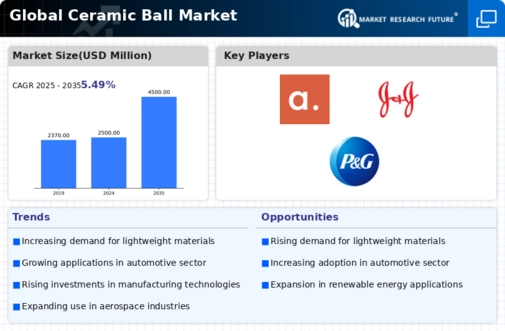Market Analysis
In-depth Analysis of Ceramic Ball Market Industry Landscape
The Ceramic Ball market is shaped by dynamic factors that influence the production, demand, and applications of these specialized balls made from ceramic materials. Ceramic balls find applications in various industries, including bearings, valves, and grinding media. The market dynamics are intricately linked to factors such as technological advancements, industrial growth, and the increasing demand for high-performance materials.
One of the key drivers of the Ceramic Ball market is the growing demand for advanced materials in the manufacturing sector. Ceramic balls are known for their superior properties such as high hardness, wear resistance, and corrosion resistance, making them ideal for critical applications in machinery components. As industries seek materials that can withstand harsh operating conditions and provide extended durability, the demand for ceramic balls in bearings, valves, and other applications increases.
The bearing industry represents a significant contributor to the market dynamics of ceramic balls. Ceramic balls are used in precision bearings, offering advantages such as reduced friction, increased speed, and longer lifespan compared to traditional steel balls. As industries like automotive, aerospace, and machinery manufacturing demand high-performance bearings, the use of ceramic balls becomes more prevalent.
Technological advancements in ceramic manufacturing processes contribute to the market dynamics of ceramic balls. Innovations in shaping methods, sintering techniques, and material compositions enhance the quality and performance of ceramic balls. Manufacturers are continually exploring ways to improve the mechanical properties of ceramic materials, expanding their applications in diverse industries.
The semiconductor and electronics industry is another major influencer of the Ceramic Ball market. Ceramic balls are utilized in check valves, flow meters, and precision measurement instruments within semiconductor manufacturing equipment. As the demand for smaller, more efficient electronic components grows, the need for high-precision ceramic balls in critical applications rises.
Supply dynamics in the Ceramic Ball market are influenced by the availability and cost of raw materials such as alumina, zirconia, and silicon nitride. The ceramic manufacturing industry, responsible for producing these raw materials, is subject to market fluctuations and global trade dynamics. Additionally, advancements in raw material processing and sourcing impact the overall supply chain of ceramic balls.
Global trade dynamics are significant in the Ceramic Ball market, with many countries involved in both the production and consumption of ceramic ball products. Trade policies, tariffs, and regional economic conditions can impact the flow of ceramic balls across borders. The market is also influenced by competition among manufacturers to develop innovative ceramic ball products with enhanced properties.
Environmental considerations and sustainability initiatives are increasingly influencing the market dynamics of ceramic balls. Companies are investing in research and development to create environmentally friendly ceramic materials, including recyclable and energy-efficient options. As industries prioritize sustainable practices, the demand for eco-friendly ceramic ball solutions is expected to increase.
Price volatility is a common factor in the Ceramic Ball market, driven by fluctuations in raw material prices, manufacturing costs, and market demand. Companies in this dynamic market must adopt effective pricing strategies and risk management practices to navigate the uncertainties associated with price variations.






Leave a Comment